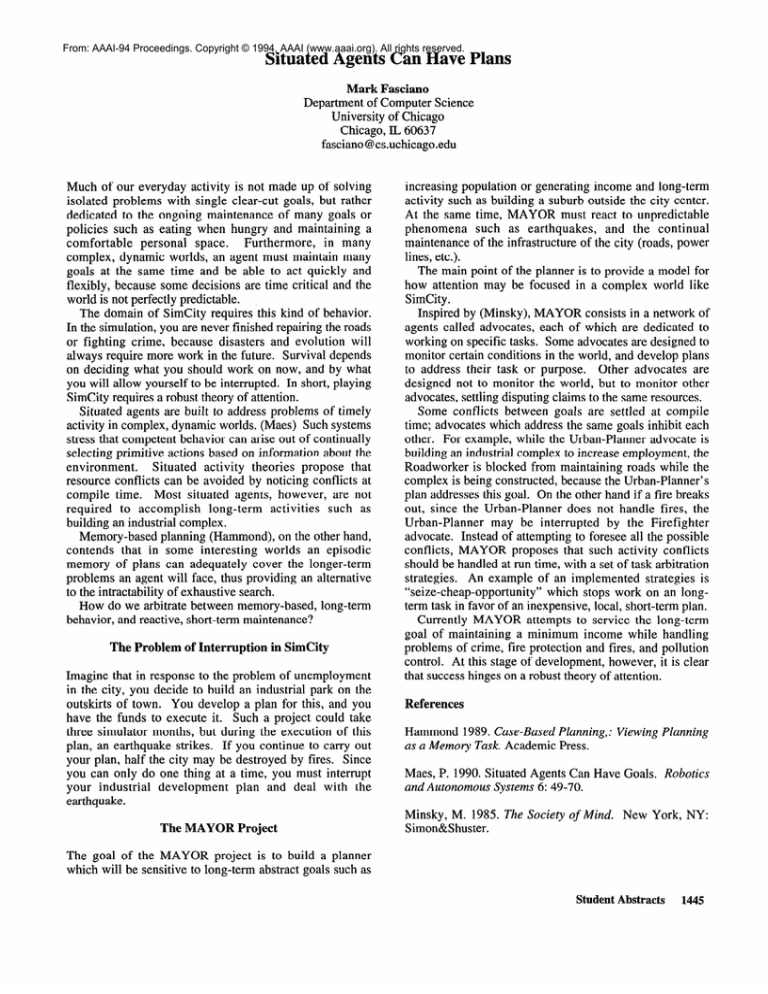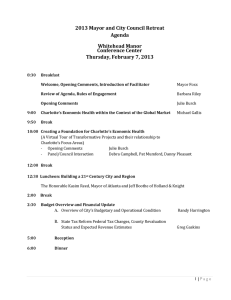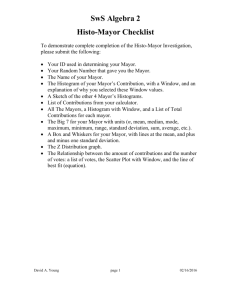
From: AAAI-94 Proceedings. Copyright © 1994, AAAI (www.aaai.org). All rights reserved.
Situated Agents Can Have Plans
Mark Fasciano
Department of Computer Science
University of Chicago
Chicago, IL 60637
fasciano@cs.uchicago.edu
Much of our everyday activity is not made up of solving
isolated problems with single clear-cut goals, but rather
dedicated to the ongoing maintenance
of many goals or
policies such as eating when hungry and maintaining
a
Furthermore,
in many
comfortable
personal
space.
complex, dynamic worlds, an agent must maintain many
goals at the same time and be able to act quickly and
flexibly, because some decisions are time critical and the
world is not perfectly predictable.
The domain of SimCity requires this kind of behavior.
In the simulation, you are never finished repairing the roads
or fighting crime, because disasters and evolution will
always require more work in the future. Survival depends
on deciding what you should work on now, and by what
you will allow yourself to be interrupted.
In short, playing
SimCity requires a robust theory of attention.
Situated agents are built to address problems of timely
activity in complex, dynamic worlds. (Maes) Such systems
stress that competent behavior can arise out of continually
selecting primitive actions based on information about the
environment.
Situated
activity theories propose that
resource conflicts can be avoided by noticing conflicts at
compile time.
Most situated agents, however, are not
required
to accomplish
long-term
activities
such as
building an industrial complex.
Memory-based planning (Hammond), on the other hand,
contends
that in some interesting
worlds an episodic
memory of plans can adequately cover the longer-term
problems an agent will face, thus providing an alternative
to the intractability of exhaustive search.
How do we arbitrate between memory-based,
long-term
behavior, and reactive, short-term maintenance?
The Problem of Interruption in SimCity
Imagine that in response to the problem of unemployment
in the city, you decide to build an industrial park on the
outskirts of town. You develop a plan for this, and you
have the funds to execute it. Such a project could take
three simulator months, but during the execution of this
plan, an earthquake strikes. If you continue to carry out
your plan, half the city may be destroyed by fires. Since
you can only do one thing at a time, you must interrupt
your industrial
development
plan and deal with the
earthquake.
The MAYOR Project
increasing population or generating income and long-term
activity such as building a suburb outside the city center.
At the same time, MAYOR must react to unpredictable
phenomena
such as earthquakes,
and the continual
maintenance of the infrastructure of the city (roads, power
lines, etc.).
The main point of the planner is to provide a model for
how attention may be focused in a complex world like
SimCity.
Inspired by (Minsky), MAYOR consists in a network of
agents called advocates, each of which are dedicated to
working on specific tasks. Some advocates are designed to
monitor certain conditions in the world, and develop plans
to address their task or purpose.
Other advocates are
designed not to monitor the world, but to monitor other
advocates, settling disputing claims to the same resources.
Some conflicts between goals are settled at compile
time; advocates which address the same goals inhibit each
other. For example, while the Urban-Planner
advocate is
building an industrial complex to increase employment, the
Roadworker is blocked from maintaining
roads while the
complex is being constructed, because the Urban-Planner’s
plan addresses this goal. On the other hand if a fire breaks
out, since the Urban-Planner
does not handle fires, the
Urban-Planner
may be interrupted
by the Firefighter
advocate. Instead of attempting to foresee all the possible
conflicts, MAYOR proposes that such activity conflicts
should be handled at run time, with a set of task arbitration
strategies.
An example of an implemented
strategies is
“seize-cheap-opportunity”
which stops work on an longterm task in favor of an inexpensive, local, short-term plan.
Currently MAYOR attempts to service the long-term
goal of maintaining
a minimum income while handling
problems of crime, fire protection and fires, and pollution
control. At this stage of development, however, it is clear
that success hinges on a robust theory of attention.
References
Hammond 1989. Case-Based Planning,:
as a Memory Task. Academic Press.
Viewing Planning
Maes, P. 1990. Situated Agents Can Have Goals.
and Autonomous Systems 6: 49-70.
Minsky, M. 1985. The Society of Mind.
Simon&Shuster.
Robotics
New York, NY:
The goal of the MAYOR project is to build a planner
which will be sensitive to long-term abstract goals such as
Student Abstracts
1445





